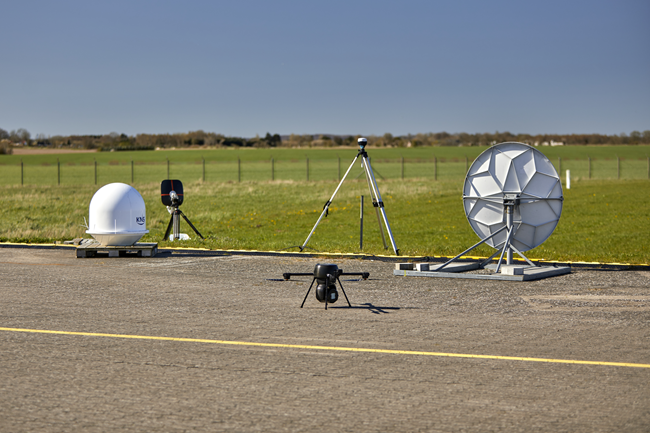
Satellite systems are an intrinsic part of modern military capabilities and threats to these systems are constantly evolving. Cyber-attacks, jamming, anti-satellite weapons (ASATs), radio frequency interference, and even debris, all present significant threats to military satellites. As described in a recent review of cyberattacks that have affected the satellite industry, deliberate attacks are becoming ever more sophisticated and difficult to defend against. We’re also seeing an increasingly congested radio frequency spectrum, and more complex networks, which together are increasing the risk of unintentional interference and making it more difficult to know if systems will work as intended when in operation. And at a time of enormous global uncertainty and instability, maintaining optimal operational performance and protecting military satellites from these constantly evolving threats is more important than ever. While the threats to military satellite systems come from a variety of sources, they can, broadly speaking, be classed as either being active or passive.
Active Threats
Given the current political climate and state of global uncertainty, the need to protect military satellite capabilities from active threats is palpable. These types of threats can have different objectives, ranging from complete destruction of a satellite to loss of critical military satellite capabilities, including communication, reconnaissance, intelligence gathering, and navigation. Understanding and mitigating these active threats, along continued investment in cybersecurity measures, is crucial for maintaining the security and effectiveness of military satellite operations.
One significant active threat is the use of ASAT weapons, which can be launched from the ground, air, or even other satellites, and are designed specifically to destroy or disable satellites. Although to date, ASATs have not been used as a warfare strategy, the capability is certainly there, so it remains a very real threat. In November 2021, Russia tested a direct-ascent anti-satellite missile. The test resulted in the destruction of a non-functional Russian satellite (Cosmos 1408), and in doing so, created a debris field in LEO.
Other active threats include the deliberate disruption of satellite systems through jamming, which is normal practice during conflict, where adversaries intentionally transmit interfering signals to disrupt satellite communications. Spoofing techniques may also be used to deceive satellite systems, leading to incorrect or misleading information being communicated.
Cyberattacks also pose a significant and ongoing threat to military satellite systems. Their intention may be to gain unauthorized access to satellite systems, or to disrupt or compromise their functionality. These attacks can also include hacking into other parts of the communication chain such as ground control systems, and exploiting vulnerabilities in software or protocols. One of the most notable cyberattacks in recent history was carried out at the start of the Russian invasion of Ukraine in February 2022 when Viasat’s KA-SAT was attacked. The attack resulted in a widespread disruption to communication networks across Ukraine, with an aim of disrupting Ukraine’s ability to respond to the invasion.
Passive Threats
Although unintentional, passive threats such as space debris and RF interference resulting from a congested spectrum and increasingly complex networks, also need to be carefully considered and mitigated. Space debris poses a significant threat to satellite systems because a collision with even just a small piece of debris can damage or destroy satellite. But not only that, the volume of debris in orbit is steadily rising, and much of the debris that poses a threat is extremely difficult to identify and track. Furthermore, a collision event would result in fragmentation which only serves to compound the problem, increasing the overall risk for all satellites.
Like debris, the risk of RF interference is certainly not a new threat but it’s one that is increasing. As a finite resource that is used by many different applications and users, the RF spectrum must be managed carefully and efficiently to minimise interference and optimise use of available frequencies. Managing the spectrum will become more challenging as the number of satellites in orbit increases, as is predicted over the coming years. Analysis by Euroconsult estimates that 2,500 satellites will be launched every year between 2022 and 2031, which represents a staggering fourfold growth.
Along with the anticipated surge in the number of satellites, many of which will be in LEO, we’re also seeing an increasingly multi-orbit environment. Earlier this year, OneWeb, Eutelsat and Intelsat signed a multi-orbit agreement to collaborate on the provision of connectivity over Europe, the Middle East, and the Pacific, and ESA recently carried out multi orbit connectivity tests. RF equipment supporting LEO and multi-orbit is much more complex than that in use for geo-stationary satellites. And it stands to reason that when ground equipment is having to operate in a more complex and dynamic way, tracking and switching between multiple gateways, the risk of error is greater.
Although it’s still not known exactly what impact a congested spectrum and more complex RF networks will have on the industry, it’s probable that we’ll see an increased risk of interference. And this will make it more difficult to obtain assurance over whether systems will function as they should do when in operation. In military satellite, the stakes are high and any uncertainty around quality assurance and performance is not acceptable. There are of course a number of ways to handle and mitigate interference, and these are well-defined and effective. However, these methods haven’t been designed to manage interference in a dynamic, multi-orbit environment. It’s likely that the tools currently in use will need to be revaluated and enhanced as the space environment evolves and networks becomes more complex.
Radar System Testing
Testing and diagnostics are critical not only for detecting sources of interference and for testing satellite antennas, but also for ensuring that radar systems are performing optimally. Radar plays a vital role in a range of military applications, including air traffic control, air and sea navigation, detection of aircraft or ships, targeting and attack, defence of critical infrastructure, and weather observation, so it’s imperative that it’s operating correctly. However, diagnostics of antennas and radar systems have historically been difficult to perform in-situ. Testing and diagnostics of radar equipment already in use on a naval vessel would typically require the ship having to enter port and dock while equipment is transferred to a testing facility. New radar equipment intended for naval vessels would normally go from the factory to being tested ashore, then on to the ship. If radar operating issues are encountered, these would have to be sorted at sea or otherwise the ship would need to return to port. The Royal Navy recently procured an experimentation ship to address this exact issue, so it can test equipment in the field prior to it going into service.

Evolving Testing and Diagnostic Capabilities
Testing capabilities are however improving and it’s now possible to test antenna and radar equipment on-site, rather than transporting equipment to testing facilities. These same test and measurement tools can be used to ensure that equipment is operating optimally under in-field conditions before deployment. Additionally, by conducting rigorous verification and testing on an ongoing basis, defence organisations can ensure that their RF equipment meets the required standards and is operating optimally at all times. Although there are a lot of uncertainties about how the spectrum will be impacted by the changing environment, there is little doubt that comprehensive testing and verification of RF equipment will help to mitigate potential disruptions and maintain a safe and efficient environment.
From active to passive threats, the threat landscape is constantly evolving, and new threats are emerging as technology advances. Defence measures and countermeasures must be continuously developed to mitigate these threats and ensure the security and resilience of military satellite systems. And there is no doubt that testing and diagnostics will continue to play a critical role in ensuring that military and defence systems are able to operate optimally at all times.


















